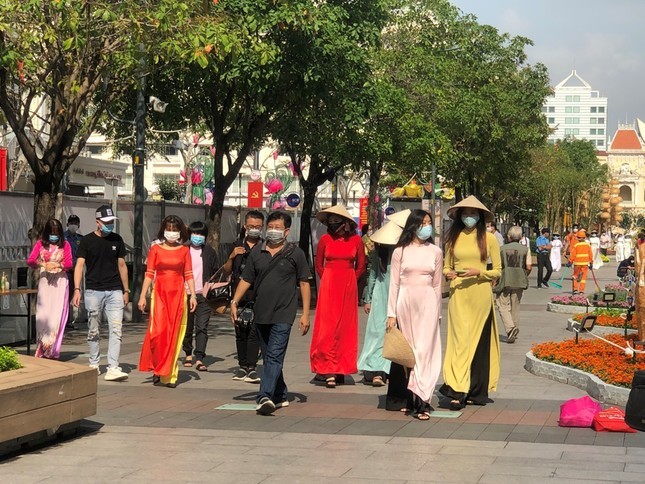Challenges facing the tourism industry
The global tourism industry, including Vietnam, has become “paralyzed” due to the pandemic. Looking back to the golden age when COVID-19 hadn’t yet appeared (from 2015-2019), international visitors to Vietnam increased by 2.3 times, from 7.9 million to 18 million; domestic visitors increased from 57 million to 85 million. In 2019, the tourism industry contributed more than 9.2% to the country’s Gross Domestic Product (GDP). Vietnam’s tourism competitiveness improved by 12 ranks, from 75th out of 141 in 2015 to 63rd out of 140 economies in 2019.

COVID-19 has put Vietnam’s tourism industry in a state of “freeze” while it was experiencing rapid growth.
While striving to become a leading economic sector, the enormous impact of the COVID-19 pandemic has plummeted Vietnam’s tourism industry, putting an end to the average growth rate of nearly 23% per year in international visitors from 2015 to 2019.
As evidence, the total revenue from tourism in 2019 was 755,000 billion VND, but it decreased to 312,000 billion VND in 2020, a 58.7% decrease compared to 2019. In 2021, it further decreased to 180,000 billion VND, a 42.3% decrease compared to 2020. Up to 95% of international travel companies have ceased operations. Many hotels and restaurants in Vietnam have had to close, with room occupancy rates reaching only 10-15% at certain periods. This has resulted in millions of people losing their jobs.
Reflecting on those difficult times, a representative from Hoa Mai Tourist Company said, “About 7-8 years ago, when Vietnam’s tourism industry was thriving and becoming an attractive destination for domestic and international tourists. However, when the pandemic hit and many countries had to close their borders and implement social distancing measures, tourism-related workers like us were left in a dire situation. In the whole year of 2020, our company only made a meager revenue of 20 million VND. It was extremely painful and bitter.”
It is not just travel businesses that have been affected, but also businesses in tourist cities. Speaking with PV of Tien Phong, Mr. N.V.H., the owner of a food and beverage store in Da Nang, shared that before the pandemic, the store used to welcome thousands of visitors per day, especially during Tet holidays.
“During that time, especially during the Lunar New Year, the number of customers coming to the store would increase by 3-4 times compared to normal days because it was the time when tourists went on pilgrimages. However, since COVID-19 hit, all businesses had to close for nearly a year. I have never seen Da Nang, a tourist city, suffer for such a long time like this. When the social distancing measures were lifted and businesses reopened, inflation surged and domestic tourists became more budget-conscious, making difficulties pile up,” Mr. N.V.H. confided.

Many accommodation facilities remained empty during the pandemic. Photo: Tran An.
Until the Lunar New Year in 2024, Vietnam’s tourism industry still faces numerous challenges. Bui Thanh Tu, a representative from Best Price travel agency, stated that the operating costs of businesses have returned to pre-pandemic levels, but their revenue has not recovered, leading to thin profit margins.
Some experts have expressed concern over changing consumer behavior, stating that it is the most important factor contributing to difficulties in the tourism industry. For example, in the past, domestic tourists used to book Lunar New Year tours more than 2 months in advance, but now they only book about 1 month in advance. This puts some businesses in a difficult situation as they had already made early bookings and now have to offer promotional programs to reduce revenue losses.
There is always light at the end of the tunnel
Despite the challenges, those working in Vietnam’s tourism industry are always prepared to adapt, and this is helping the tourism economy recover. After COVID-19, domestic tourism reached a new peak in 2022 with 101.3 million tourists, an increase of 168.3% compared to the plan. In 2023, domestic tourists continued to grow, reaching 108 million visitors.
The number of Vietnamese tourists traveling abroad is expected to reach 10 million in 2023. The international market to Vietnam is projected to accelerate with 12.6 million visitors in 2023.

International tourists are increasingly interested in destinations in Vietnam. Photo: Tran An.
The report from the General Statistics Office showed that the revenue from accommodation and food services in 2023 is estimated to exceed 670,000 billion VND, accounting for 10.8% of the total and increasing by 14.7% compared to the previous year. The revenue from travel agencies is estimated at 37,800 billion VND, an increase of 52.5% compared to the previous year.
Research also shows that after being isolated at home for so long due to the pandemic, people appreciate their trips more. However, the difficult economic situation makes people more cautious when spending. Tourists now only want to participate in new and worthy trips that are worth every penny they have spent. Faced with the opportunity to restore revenue to the original trajectory, travel companies are introducing new products.
“Instead of going on 6-day-5-night tours, we now offer longer tours to attractive destinations such as Japan, Korea, Taiwan, and Europe. At the same time, we always strive to offer the latest products. For example, before Tet, companies will begin accepting bookings for the holiday period from April 30th to May 1st,” Mr. Bui Thanh Tu from BestPrice Travel shared.

Vietnamese tourists are ready to participate in new and exciting trips. Photo: Le Viet Vinh.
Many travel experts believe that the recent surge in people visiting snow-covered destinations this winter demonstrates that tourists are eager and willing to spend money on unique trips. It is crucial for travel businesses, tourism management boards, and local authorities to professionalize all operations to provide the best services and create a sustainable market.
In addition, digital transformation investment is becoming particularly important. Currently, many agencies in Hanoi’s Old Quarter mainly deal directly with customers, resulting in decreased revenue from short-term tours. In the case of long-term tours, tourists are more interested in online ticket booking channels, where they can apply discount codes to save significant costs.

International tourists are only interested in short-term tours with low costs when booking directly. Photo: Tran An.
Furthermore, travel companies share that in order to operate stably, stimulate demand, and contribute to the development of the tourism industry, essential support options are needed from all levels of government. In particular, to ensure cash flow, many airlines now require travel operators to make a deposit for purchasing air tickets for the whole year instead of on a quarterly basis as before.
This requires travel agencies to invest a considerable amount of capital, estimated at around 10 billion VND per international flight segment per year. Many representatives of travel companies have shared that obtaining loans from banks for travel companies is often more challenging than for manufacturing firms due to a lack of tangible assets. Therefore, travel agency representatives hope that in the future, Vietnam will have suitable loan packages for this specific type of business.




![[Photo Essay]: Experts, Managers, and Businesses Unite to Forge a Path Towards Sustainable Green Industry](https://xe.today/wp-content/uploads/2025/07/z678592918-150x150.jpg)


![[Photo Essay]: Experts, Managers, and Businesses Unite to Forge a Path Towards Sustainable Green Industry](https://xe.today/wp-content/uploads/2025/07/z678592918-100x70.jpg)




